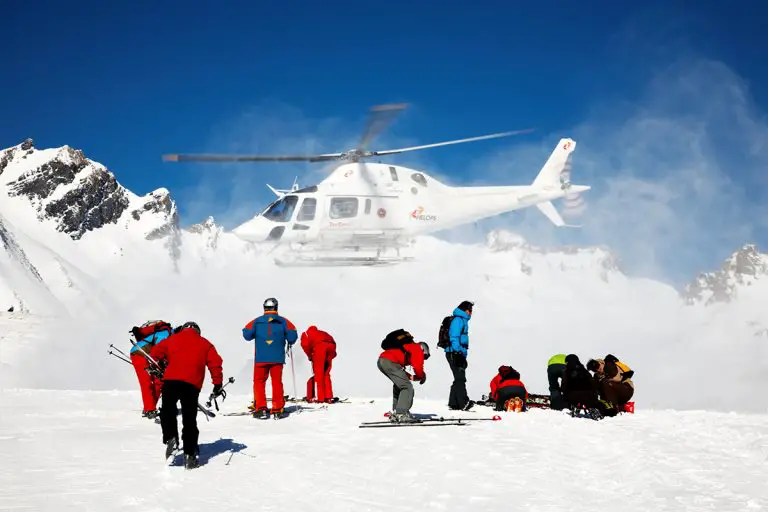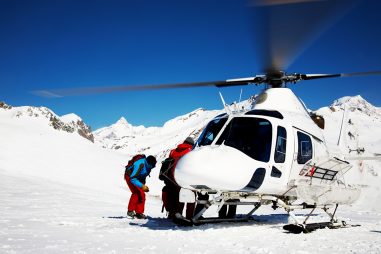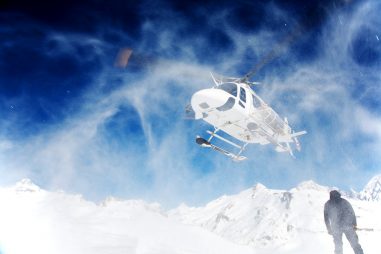The biggest downsides of resort skiing are the large crowd, the long queues, and the tracked-out snow, all of which can make your trip less enjoyable than it should be. But with heli skiing, you get the chance to ride on powder snow in the remote and majestic backcountry terrains, which is a whole new adventure awaiting skiing enthusiasts.
What Does Heli Skiing Mean?
Heli skiing is an off the trail downhill skiing which requires a helicopter to reach the backcountry terrain. Aside from the helicopter ride, what makes heli skiing special are the untouched areas where the sport is played. These trails are remote with powder-like snow and are rarely visited, making them a different experience from the usual ski resorts.
How Does Helicopter Skiing Work?
With helicopter skiing, you need to take a helicopter to access the backcountry terrains. But of course, you can’t just hop onto your chopper and ride out into the mountains whenever you want to. Heli skiing companies will provide you with experts to guide you in your adventure. These guides are essential as they know the area well and will bring you to the safe trails for heli skiing.
And despite what the name says or what you see in the movies, you don’t jump out of the helicopter and ski down the slope. It’s just the means of transportation to bring you to the backcountry terrain. From there, you ski in a majestic landscape on powder snow.
Why Do People Go Heli Skiing?
People choose to heli ski for different reasons. But in terms of the sport’s mechanics and fundamentals, heli skiing is no different from resort skiing. But if that’s the case, why go heli skiing? Here are the top reasons why.
- The helicopter ride: One of the coolest things about heli skiing is the helicopter ride. It’s not every day you get to ride a helicopter and that in itself is a memorable experience already. Not to mention the beautiful views of the mountains you’ll be treated to as you head out into untouched territory. Plus, it’s your personal chairlift!
- Skiing on virgin powder snow: Skiing on powder snow makes all the difference. The whole terrain is untracked, providing a better skiing experience versus resort skiing where you’ll be lucky to find untracked turns.
- The majestic environment: The virgin snow, the remote and wide-open backcountry terrain make heli skiing areas beautiful to behold. You won’t get these views in your usual ski resort.
- No crowds: The bane of every resort skier, the big crowds result in long wait times for the chairlift in the freezing cold and tracked-out slopes. You’ll be lucky to get a few rounds on the slope if you line up early!
- More fun and adventurous experience: Combining the personal helicopter ride, the remote territory, and virgin powder snow, heli skiing provides a more fun and adventurous experience that resort skiing just can’t duplicate.
Is Heli Skiing Safe or Dangerous?
Heli skiing in the movies isn’t the same as commercial heli skiing. It’s actually safer than what the media portrays. Nobody jumps off a helicopter down to speed down on the slope with no regard for life.
Heli skiing companies employ different measures to ensure safety. Before you can even lift off, skiers are oriented on equipment use, helicopter safety, rescue techniques, and more. Every heli skiing trip will have guides who are experts on the weather conditions and the terrain. They’ll take you to areas that have been proven to be safe and will avoid high-risk terrains.
Why Is Helicopter Skiing Dangerous?
While helicopter skiing is generally safe, it’s not without its risks and dangers, such as the following:
- Avalanche risk: It’s one of the primary risks when skiing in a remote area in the mountains. Some heli skiing operators take to blasting to create controlled avalanches as a form of avalanche control and defense. Meanwhile. others avoid avalanche-prone areas altogether.
- Helicopter safety: Like driving a vehicle, the machine’s condition, as well as pilot skill and experience, can spell the difference in safety.
- Backcountry hazards: Because of its remoteness, some backcountry hazards might be present like holes, tree wells, tree stumps, cliffs, and more. These risks are mostly present in uninspected or uncontrolled areas.
- Wild animals: There’s always the slim chance that wild animals would appear given that the area is usually void of human activity.
You can minimize any dangers by making sure you pick a reliable and trusted heli skiing service provider. Safety should be the utmost priority at all times. Safety training must be given beforehand and protocol must be followed strictly. Never head out without any guides or go to unscouted terrains to avoid the risks mentioned above.
Do People Die Heli Skiing?
Throughout history, fatalities have happened in sports and activities like motor racing, surfing, scuba diving, and the like. However, these usually occur because of accidents or when failing to follow rules on safety.
The same applies to heli skiing. The risk of injury or death is minimal if safety protocols are followed and the terrain properly inspected. However, death may still occur while skiing but much of the risk lies in natural hazards and accidents.
In research done by Science Direct on the risk of death from heli skiing, they recorded 18.67 deaths per million skier days from 1997 to 2006. It’s a small percentage but the numbers increase dramatically with natural hazards, with avalanches being the largest contributor to the risk of death at 77%.
Recently a helicopter accident has claimed 5 lives in Alaska, with the cause of the crash unknown. It’s not an accident unique to heli skiing, however, the unpredictability of such events can make it seem dangerous.
So yes, people can die while heli skiing, but it’s mostly because of natural hazards or accidents. But by following safety protocols and taking the necessary precautions, injury or death can be avoided.
Is Heli Skiing an Extreme Sport?
Extreme sport is defined as a sport or activity that’s characterized by high risk at high speeds. In this sense, heli skiing is considered one because of its freestyle nature as well as the risk involved in skiing on unfamiliar slopes that may have natural hazards.
Extreme sports or activities are usually done by experts, but in this case, you don’t need to be one to heli ski. So even if you can consider heli skiing as an extreme sport, it’s not as extreme compared to skydiving and bungee jumping.
How Hard and Difficult Is Heli Skiing?
The immediate perception is that heli skiing is difficult, especially if you believe that you need to jump off a helicopter. But contrary to this perception, heli skiing isn’t that hard if you already know the fundamentals. As mentioned above, you don’t even need to be an expert skier, but you do need to have intermediate skills.
Yet what makes it intimidating for some is the powder snow. Skiing on powder snow is a different experience and it’s no comparison to the snow quality at ski resorts. It’s the best kind of snow to ski on. If it’s your first time skiing on powder snow, your guides will train you on how to handle the terrain.
The unfamiliar terrain can also make it challenging, hence the need to be an intermediate skier so you can navigate the trail on your freerun. This makes it important that you’re comfortable in your skiing abilities and you’re up for this challenge.
Can Anyone Heli Ski?
Because of the skills required and the potential hazards, not anyone can heli ski. Certain requirements need to be met before taking on the backcountry powder snow.
How Old Do You Have to Be to Heli Ski?
The minimum age requirement is 16 years to be able to heli ski. Some heli ski companies may allow children under 16 provided that they’re with family. If you want to bring someone below 16 years of age, be sure to check with your preferred heli skiing company.
How Good Do You Have to Be to Go Heli Skiing?
You don’t have to be an expert skier to heli ski but you need to have intermediate skills at the least. You can determine this if you have taken on the blue (intermediate) runs on ski resorts. Once you got that handled, you’re good enough to heli ski.
How Do You Get Into Heli Skiing?
Before you can get into heli skiing, you need to reach the minimum skill level first and you can do that by practicing at ski resorts. Once you’ve reached that level, you can now move on to heli skiing.
But one of the first things you have to know is that heli skiing doesn’t come cheap. Depending on where you’ll be taking your adventure, expect to spend thousands of dollars, up to 6 figures if you want the best accommodations and logistics.
You can find different heli ski providers in different countries like the US, Switzerland, Canada, Russia, and Greenland. From there, you can choose which destination you like and sign up for the heli skiing trip.
As for the season, the best time is to go during winter which is the traditional skiing season. But since you’ll be skiing in the backcountry where it’s much colder, you’ll be able to heli ski up until April or May, depending on where you’ll be taking your trip.
How Do I Prepare for Heli Skiing?
Aside from preparing your finances and the logistics, you need to be physically prepared and have the right equipment. Most importantly, you need to understand helicopter safety and other protocols in emergencies.
As mentioned, you need intermediate skills to heli ski. Controlled panel turns on steep terrain, kick-turning and side-slipping are just a few maneuvers you need to know to ride the powder snow with ease.
In case you haven’t gotten the chance to practice on powder snow, your guides will be teaching you the fundamentals and can provide the necessary equipment to prepare you for your first time.
Safety preparations are also critical. On your first trip, helicopter flight safety should be conducted to orient you on seat belt usage, how to exit in emergencies, as well as how to disembark without getting hurt or killed by the propellers.
How Do I Get in Shape for Helicopter Skiing?
Aside from having adequate skiing skills, you need to be in good health and be physically fit for helicopter skiing. Endurance and adapting to the cold are key to enjoying your heli skiing adventure.
How to get in shape? You need to ski a lot during the months leading up to your trip. It’s the best way to get into skiing shape even if the ski resort conditions aren’t ideal. It will also help your body acclimate to the cold weather.
If you want to take it further, you can hit the gym on your non-skiing days to strengthen your body and maintain conditioning. Focus on compound exercises for the lower body and your core to give your legs the power and endurance for you to perform better on the mountain. Stronger legs can also help prevent any injuries. And while it may take you a few rounds to get used to the powder snow, at least you won’t be worn out.
What Do You Need for Heli Skiing?
Ask anyone who’s ever tried heli skiing and the first thing they’ll tell you is you need a positive attitude. You’ll be having a unique experience in the mountains, very much different from what you’ll get from a ski resort. You may encounter unforeseen circumstances and a positive attitude will help you enjoy your trip despite a few bumps along the way.
You’ll also need a specific set of skiing gear for heli skiing. The deep powder snow calls for wide and short skis which you can rent in case you don’t have any of those. Then you’ll need the standard skiing gear: goggles, helmet, ski boots, gloves, poles, and layers.
What to Bring for Heli Skiing?
Other than skiing gear, you’ll also need safety equipment and your other essentials to make your stay in the mountains as comfortable as possible.
Some of the mandatory safety equipment you need are:
- Avalanche transceiver
- Probe
- Shovel
- Avalanche airbag backpack
In the event of an avalanche and you get trapped underneath the snow, your transceiver will let others know of your location. Meanwhile, those looking for you will use the probe to track your location and dig you out using a shovel.
Meanwhile, you use the avalanche airbag backpack if you find yourself falling in an avalanche. By inflating the bag, you’re lifted above the avalanche, increasing your chances of survival by 50%. Expect some heli skiing services to require the use of this backpack.
Now for your essentials, you’ll need water to keep yourself hydrated as well as snacks to keep your energy up. And if your lodging has a hot tub, be sure to bring swimwear so you can relax at the end of the day.
Where Did Heli Skiing Originate?
It’s widely accepted and believed that heli skiing originated in British Columbia, Canada.
Who Invented Heli Skiing?
As for its inventor, historians credit Hans Gomer, a mountain guide who was originally from Austria. In April of 1965, his ski guests presented him with the idea of taking a helicopter to the remote backcountry mountains for a ski run. Thus, heli skiing was born.
Who Started CMH?
CMH or Canadian Mountain Holidays was founded by Hans Gomer to provide heli skiing services and lodging to skiing enthusiasts. The company was formed in 1957, soon after his first heli skiing trip. It’s one of the world’s biggest heli skiing companies that offers the best ski runs in the remote mountains of British Columbia.
Is Heli Skiing Bad for the Environment?
Environmentalists report that using helicopters in heli skiing consumes a large volume of fuel which contributes to increased greenhouse gas emissions and global warming. Concerns have also been raised about the damage done by the helicopters when they land on the soil as well as the waste left behind by skiers on the mountains.
On the other hand, some studies have shown that heli skiing has a minimal impact on the environment, especially when compared to other activities that burn more fossil fuels. Despite this, many heli skiing companies have taken steps to reduce greenhouse gasses and the use of fossil fuels in their operations. While it can’t be helped as helicopter fuel, some have switched to sustainable energy sources to power their lodges and offer clients an opportunity to offset their trip’s carbon emissions.
Why Was Heli Skiing Banned?
Heli skiing is currently banned in some countries like Germany and France because of environmental concerns detailed above as well as the noise pollution it generates. Some environmental groups continue to push for its ban in other countries as well.



